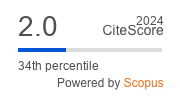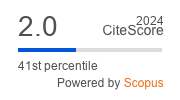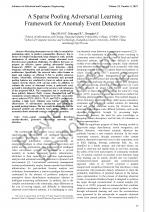| 2/2025 - 6 |
A Sparse Pooling Adversarial Learning Framework for Anomaly Event DetectionZHANG, M. |
| Extra paper information in |
| Click to see author's profile in |
| Download PDF |
Author keywords
smart community, anomaly detection, encoder-decoder, generative adversarial networks, self-attention
References keywords
detection(32), anomaly(25), video(18), vision(15), recognition(13), pattern(13), learning(12), systems(9), networks(8), neural(7)
Blue keywords are present in both the references section and the paper title.
About this article
Date of Publication: 2025-06-30
Volume 25, Issue 2, Year 2025, On page(s): 49 - 58
ISSN: 1582-7445, e-ISSN: 1844-7600
Digital Object Identifier: 10.4316/AECE.2025.02006
Abstract
Detecting abnormal event in video is essential for maintaining safety in modern communities. However, due to factors of complex background, large changes in scale, and the randomness of abnormal events, causing abnormal event detection poses significant challenges. To address the issue, we propose an effective sparse pooling adversarial learning framework (SPLF) for anomaly event detection, which integrates self-attention and pyramid features into a unified architecture. Specifically, the network takes video frames as input and employs an efficient U-Net to predict unknown frames. Meanwhile, self-attention mechanism and pyramid pooling features are combined to focus on salient areas and capture moving objects with varying scales. In addition, to evaluate the scores of abnormal events, a multi-scale error pyramid is introduced to improve the accuracy and robustness of the proposed SPLF. The comparison test is conducted on three publicly datasets: Ped2, Avenue, ShanghaiTech and a community scenario dataset. The frame-level AUC (area under curve) achieves 97.5%, 89.2%, 75.1% and 70.2% respectively, reaching a high level. Ablation tests further validate the effectiveness of self-attention mechanism and multi-scale pyramid pooling features. The test results demonstrate that the proposed method can effectively learn action patterns and accurately detect abnormal events in community scenarios. |
| References | | | Cited By |
Information from Web of Science® will be displayed on the next page reload.
We were unable to retrieve information about this paper in SCOPUS®.
Message: [Returned results: 0]
There are no citing papers in the CrossRef Cited-by Linking system.
Disclaimer: All information displayed above was retrieved by using remote connections to respective databases. For the best user experience, we update all data by using background processes, and use caches in order to reduce the load on the servers we retrieve the information from. As we have no control on the availability of the database servers and sometimes the Internet connectivity may be affected, we do not guarantee the information is correct or complete. For the most accurate data, please always consult the database sites directly. Some external links require authentication or an institutional subscription.
Web of Science® is a registered trademark of Clarivate Analytics, Scopus® is a registered trademark of Elsevier B.V., other product names, company names, brand names, trademarks and logos are the property of their respective owners.
Faculty of Electrical Engineering and Computer Science
Stefan cel Mare University of Suceava, Romania
All rights reserved: Advances in Electrical and Computer Engineering is a registered trademark of the Stefan cel Mare University of Suceava. No part of this publication may be reproduced, stored in a retrieval system, photocopied, recorded or archived, without the written permission from the Editor. When authors submit their papers for publication, they agree that the copyright for their article be transferred to the Faculty of Electrical Engineering and Computer Science, Stefan cel Mare University of Suceava, Romania, if and only if the articles are accepted for publication. The copyright covers the exclusive rights to reproduce and distribute the article, including reprints and translations.
Permission for other use: The copyright owner's consent does not extend to copying for general distribution, for promotion, for creating new works, or for resale. Specific written permission must be obtained from the Editor for such copying. Direct linking to files hosted on this website is strictly prohibited.
Disclaimer: Whilst every effort is made by the publishers and editorial board to see that no inaccurate or misleading data, opinions or statements appear in this journal, they wish to make it clear that all information and opinions formulated in the articles, as well as linguistic accuracy, are the sole responsibility of the author.



